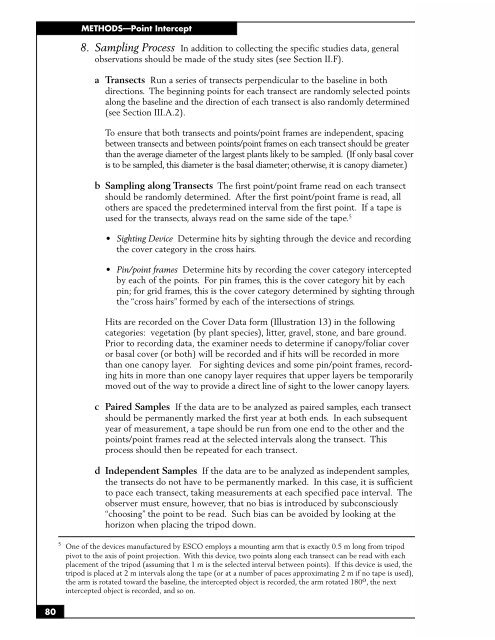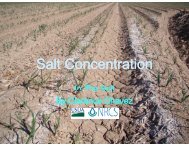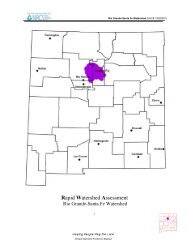SAMPLING VEGETATION ATTRIBUTES - New Mexico NRCS - US ...
SAMPLING VEGETATION ATTRIBUTES - New Mexico NRCS - US ...
SAMPLING VEGETATION ATTRIBUTES - New Mexico NRCS - US ...
You also want an ePaper? Increase the reach of your titles
YUMPU automatically turns print PDFs into web optimized ePapers that Google loves.
80<br />
METHODS—Point Intercept<br />
8. Sampling Process In addition to collecting the specific studies data, general<br />
observations should be made of the study sites (see Section II.F).<br />
a Transects Run a series of transects perpendicular to the baseline in both<br />
directions. The beginning points for each transect are randomly selected points<br />
along the baseline and the direction of each transect is also randomly determined<br />
(see Section III.A.2).<br />
To ensure that both transects and points/point frames are independent, spacing<br />
between transects and between points/point frames on each transect should be greater<br />
than the average diameter of the largest plants likely to be sampled. (If only basal cover<br />
is to be sampled, this diameter is the basal diameter; otherwise, it is canopy diameter.)<br />
b Sampling along Transects The first point/point frame read on each transect<br />
should be randomly determined. After the first point/point frame is read, all<br />
others are spaced the predetermined interval from the first point. If a tape is<br />
used for the transects, always read on the same side of the tape. 5<br />
• Sighting Device Determine hits by sighting through the device and recording<br />
the cover category in the cross hairs.<br />
• Pin/point frames Determine hits by recording the cover category intercepted<br />
by each of the points. For pin frames, this is the cover category hit by each<br />
pin; for grid frames, this is the cover category determined by sighting through<br />
the “cross hairs” formed by each of the intersections of strings.<br />
Hits are recorded on the Cover Data form (Illustration 13) in the following<br />
categories: vegetation (by plant species), litter, gravel, stone, and bare ground.<br />
Prior to recording data, the examiner needs to determine if canopy/foliar cover<br />
or basal cover (or both) will be recorded and if hits will be recorded in more<br />
than one canopy layer. For sighting devices and some pin/point frames, recording<br />
hits in more than one canopy layer requires that upper layers be temporarily<br />
moved out of the way to provide a direct line of sight to the lower canopy layers.<br />
c Paired Samples If the data are to be analyzed as paired samples, each transect<br />
should be permanently marked the first year at both ends. In each subsequent<br />
year of measurement, a tape should be run from one end to the other and the<br />
points/point frames read at the selected intervals along the transect. This<br />
process should then be repeated for each transect.<br />
d Independent Samples If the data are to be analyzed as independent samples,<br />
the transects do not have to be permanently marked. In this case, it is sufficient<br />
to pace each transect, taking measurements at each specified pace interval. The<br />
observer must ensure, however, that no bias is introduced by subconsciously<br />
“choosing” the point to be read. Such bias can be avoided by looking at the<br />
horizon when placing the tripod down.<br />
5 One of the devices manufactured by ESCO employs a mounting arm that is exactly 0.5 m long from tripod<br />
pivot to the axis of point projection. With this device, two points along each transect can be read with each<br />
placement of the tripod (assuming that 1 m is the selected interval between points). If this device is used, the<br />
tripod is placed at 2 m intervals along the tape (or at a number of paces approximating 2 m if no tape is used),<br />
the arm is rotated toward the baseline, the intercepted object is recorded, the arm rotated 180 o , the next<br />
intercepted object is recorded, and so on.




